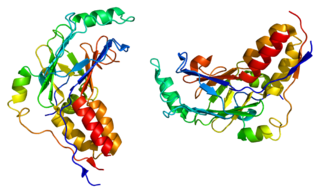Related Research Articles

Fibrodysplasia ossificans progressiva (FOP) is an extremely rare connective tissue disease. It is a severe, disabling disease with no cure or treatment and is the only known medical condition where one organ system changes into another.

Mothers against decapentaplegic homolog 2 also known as SMAD family member 2 or SMAD2 is a protein that in humans is encoded by the SMAD2 gene. MAD homolog 2 belongs to the SMAD, a family of proteins similar to the gene products of the Drosophila gene 'mothers against decapentaplegic' (Mad) and the C. elegans gene Sma. SMAD proteins are signal transducers and transcriptional modulators that mediate multiple signaling pathways.

Mothers against decapentaplegic homolog 7 or SMAD7 is a protein that in humans is encoded by the SMAD7 gene.
The transforming growth factor beta (TGFB) signaling pathway is involved in many cellular processes in both the adult organism and the developing embryo including cell growth, cell differentiation, apoptosis, cellular homeostasis and other cellular functions. In spite of the wide range of cellular processes that the TGFβ signaling pathway regulates, the process is relatively simple. TGFβ superfamily ligands bind to a type II receptor, which recruits and phosphorylates a type I receptor. The type I receptor then phosphorylates receptor-regulated SMADs (R-SMADs) which can now bind the coSMAD SMAD4. R-SMAD/coSMAD complexes accumulate in the nucleus where they act as transcription factors and participate in the regulation of target gene expression.

Bone morphogenetic protein receptor type II or BMPR2 is a serine/threonine receptor kinase. It binds Bone morphogenetic proteins, members of the TGF beta superfamily of ligands, which are involved in paracrine signalling. BMPs are involved in a host of cellular functions including osteogenesis, cell growth and cell differentiation. Signaling in the BMP pathway begins with the binding of a BMP to the type II receptor. This causes the recruitment of a BMP type I receptor, which it phosphorylates. The Type I receptor phosphorylates an R-SMAD a transcriptional regulator.

The bone morphogenetic protein receptor, type IA also known as BMPR1A is a protein which in humans is encoded by the BMPR1A gene. BMPR1A has also been designated as CD292.

The activin A receptor also known as ACVR1C or ALK-7 is a protein that in humans is encoded by the ACVR1C gene. ACVR1C is a type I receptor for the TGFB family of signaling molecules.
The Activin type I receptors transduce signals for a variety of members of the Transforming growth factor beta superfamily of ligands. This family of cytokines and hormones include activin, Anti-müllerian hormone (AMH), bone morphogenetic proteins (BMPs), and Nodal. They are involved in a host of physiological processes including, growth, cell differentiation, homeostasis, osteogenesis, apoptosis and many other functions. There are three type I Activin receptors: ACVR1, ACVR1B, and ACVR1C. Each bind to a specific type II receptor-ligand complex.

Activin receptor type-1B is a protein that in humans is encoded by the ACVR1B gene.

Activin A receptor, type I (ACVR1) is a protein which in humans is encoded by the ACVR1 gene; also known as ALK-2. ACVR1 has been linked to the 2q23-24 region of the genome. This protein is important in the bone morphogenic protein (BMP) pathway which is responsible for the development and repair of the skeletal system. While knock-out models with this gene are in progress, the ACVR1 gene has been connected to Fibrodysplasia Ossificans Progressiva, a disease characterized by the formation of heterotopic bone throughout the body.

Activin receptor type-2A is a protein that in humans is encoded by the ACVR2A gene. ACVR2A is an activin type 2 receptor.
The activin type 2 receptors belong to a larger TGF-beta receptor family and modulate signals for transforming growth factor beta ligands. These receptors are involved in a host of physiological processes including, growth, cell differentiation, homeostasis, osteogenesis, apoptosis and many other functions. There are two activin type two receptors: ACVR2A and ACVR2B.

Activin receptor type-2B is a protein that in humans is encoded by the ACVR2B gene. ACVR2B is an activin type 2 receptor.
Transforming growth factor beta (TGFβ) receptors are single pass serine/threonine kinase receptors that belong to TGFβ receptor family. They exist in several different isoforms that can be homo- or heterodimeric. The number of characterized ligands in the TGFβ superfamily far exceeds the number of known receptors, suggesting the promiscuity that exists between the ligand and receptor interactions.

Transforming growth factor beta receptor I is a membrane-bound receptor protein for the TGF beta superfamily of signaling ligands. TGFBR1 is its human gene.

Growth differentiation factor 2 (GDF2) also known as bone morphogenetic protein (BMP)-9 is a protein that in humans is encoded by the GDF2 gene. GDF2 belongs to the transforming growth factor beta superfamily.

Bone morphogenetic protein receptor type-1B also known as CDw293 is a protein that in humans is encoded by the BMPR1B gene.
An Activin receptor is a receptor which binds activin.

Serine/threonine-protein kinase receptor R3 is an enzyme that in humans is encoded by the ACVRL1 gene.

Activin and inhibin are two closely related protein complexes that have almost directly opposite biological effects. Identified in 1986, activin enhances FSH biosynthesis and secretion, and participates in the regulation of the menstrual cycle. Many other functions have been found to be exerted by activin, including roles in cell proliferation, differentiation, apoptosis, metabolism, homeostasis, immune response, wound repair, and endocrine function. Conversely, inhibin downregulates FSH synthesis and inhibits FSH secretion. The existence of inhibin was hypothesized as early as 1916; however, it was not demonstrated to exist until Neena Schwartz and Cornelia Channing's work in the mid 1970s, after which both proteins were molecularly characterized ten years later.
References
- ↑ Fliesler SJ, Kisselev OG (26 December 2007). Signal Transduction in the Retina. CRC Press. pp. 273–. ISBN 978-1-4200-0716-9.
- ↑ Thiriet M (14 December 2011). Signaling at the Cell Surface in the Circulatory and Ventilatory Systems. Springer Science & Business Media. pp. 666–. ISBN 978-1-4614-1991-4.
| This article about a biochemical receptor is a stub. You can help Wikipedia by expanding it. |